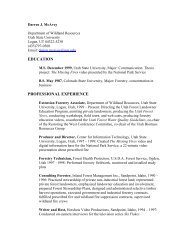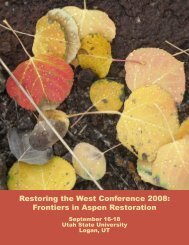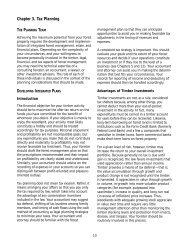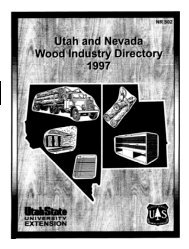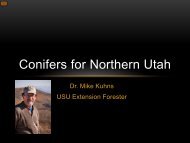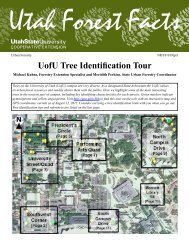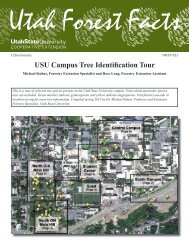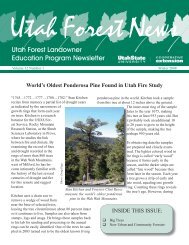A Technical Manual for Landowners, Loggers, and ... - Forestry
A Technical Manual for Landowners, Loggers, and ... - Forestry
A Technical Manual for Landowners, Loggers, and ... - Forestry
Create successful ePaper yourself
Turn your PDF publications into a flip-book with our unique Google optimized e-Paper software.
I N T RO D U C T I O N<br />
6 page<br />
D i s s o lved Oxyge n - Dissolved oxygen concentration in the water is an<br />
important indicator of overall water quality. Insufficient dissolved oxygen in<br />
water leads to anaerobic decomposition of organic matter which can cause<br />
problems with drinking water.<br />
Wa ter Te mp e ra t u re - When streamside vegetation is removed by timber<br />
harvesting, water temperatures generally increase. For streams in the lower<br />
watershed, flows begin to play a primary role in regulating water temperatures.<br />
High water temperatures can be detrimental to aquatic life <strong>and</strong> may contribute<br />
to low dissolved oxygen levels in the water.<br />
Nutrients - Concentrations of inorganic nutrients in streams may increase<br />
after timber harvesting. Burning slash may also increase nutrient releases.<br />
Excessive nutrients may cause algal blooms in lakes <strong>and</strong> streams, which can<br />
reduce levels of dissolved oxygen in the water below what fish <strong>and</strong> other<br />
aquatic species need to survive. Restricting the application of chemicals, slash<br />
b u rning next to streamsides <strong>and</strong> using buffer zones will help minimize potential<br />
nutrient problems in streams.<br />
Chemicals - Pesticides, fertilizers <strong>and</strong> fire retardants applied to the watershed<br />
can ultimately be delivered to the stream through runoff or drift from aerial<br />
spraying. In some instances, low-level concentrations can be toxic to humans,<br />
fish <strong>and</strong> other wildlife. Also, fuel, oil <strong>and</strong> coolants used in harvesting <strong>and</strong><br />
road-building equipment must be h<strong>and</strong>led carefully to avoid water pollution.<br />
P R E H A RV E S T P L A N N I N G<br />
Careful planning <strong>for</strong> <strong>for</strong>est management activities, such as road construction,<br />
timber harvesting <strong>and</strong> site preparation, will help minimize non-point source<br />
pollution. Preparing a plan will lead to harvest operations that use the<br />
FWQGs, remove <strong>for</strong>est products efficiently <strong>and</strong> profitably, <strong>and</strong> promote sustainable<br />
<strong>for</strong>est growth <strong>and</strong> water quality protection.<br />
The first step in this process is the development of a comprehensive <strong>for</strong>est<br />
management plan which includes the Forest Water Quality Guidelines. The<br />
planning process should help identify major goals <strong>and</strong> objectives, establish<br />
priorities <strong>and</strong> address management strategies to protect soil <strong>and</strong> water<br />
resources. <strong>Forestry</strong>, Fire & State L<strong>and</strong>s service <strong>for</strong>esters are available to help<br />
develop <strong>for</strong>est management plans <strong>and</strong> provide other technical assistance.<br />
Recommended Practice St<strong>and</strong>ards <strong>and</strong> Guidelines<br />
■ Contact a professional <strong>for</strong>ester or other resource manager <strong>for</strong><br />
assistance with developing a <strong>for</strong>est management plan.<br />
■ Pre p a re a list of all applicable site-specific Forest Water<br />
Quality Guidelines needed to protect water quality. Make the<br />
FWQGs a part of all timber sale agreements, timber harvest<br />
plans <strong>and</strong> <strong>for</strong>est management plans.<br />
■ Identify <strong>and</strong> locate environmentally sensitive areas utilizing<br />
re s o u rces such as topographic maps, aerial photographs or<br />
field observations.<br />
■ Locate <strong>and</strong> mark streamside management zones (SMZs).<br />
■ Consider physical features such as topography, soils, slope<br />
<strong>and</strong> aspect.<br />
■ Identify the most appropriate harvest system <strong>for</strong> the site.<br />
Consider ground-based, cable, or aerial systems.<br />
page 7



